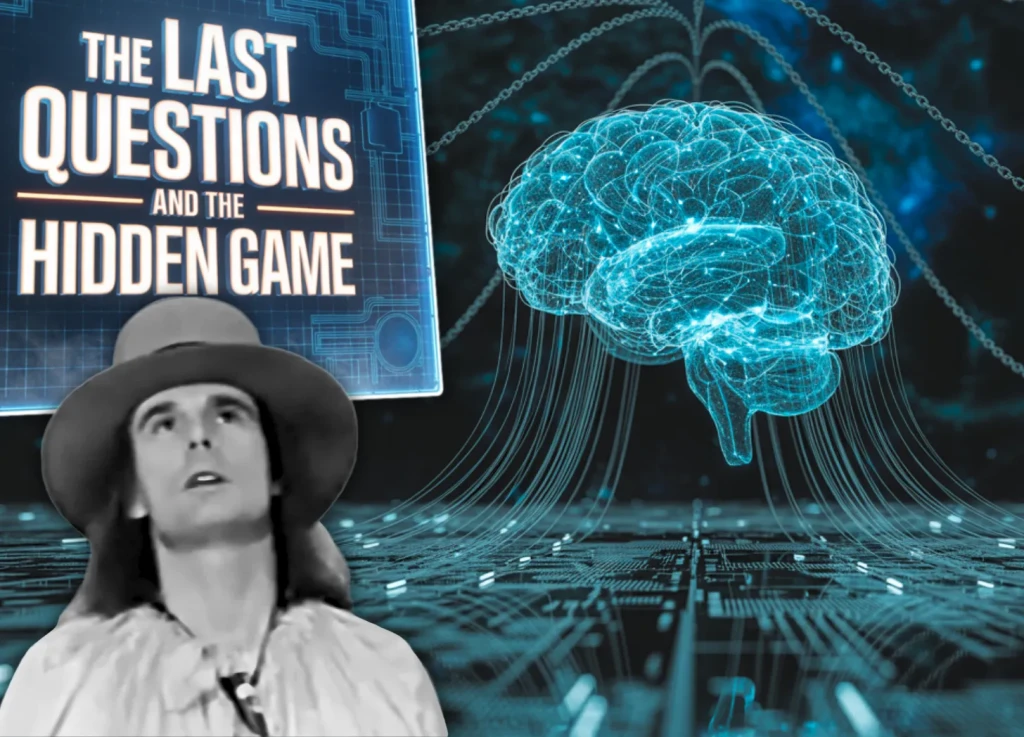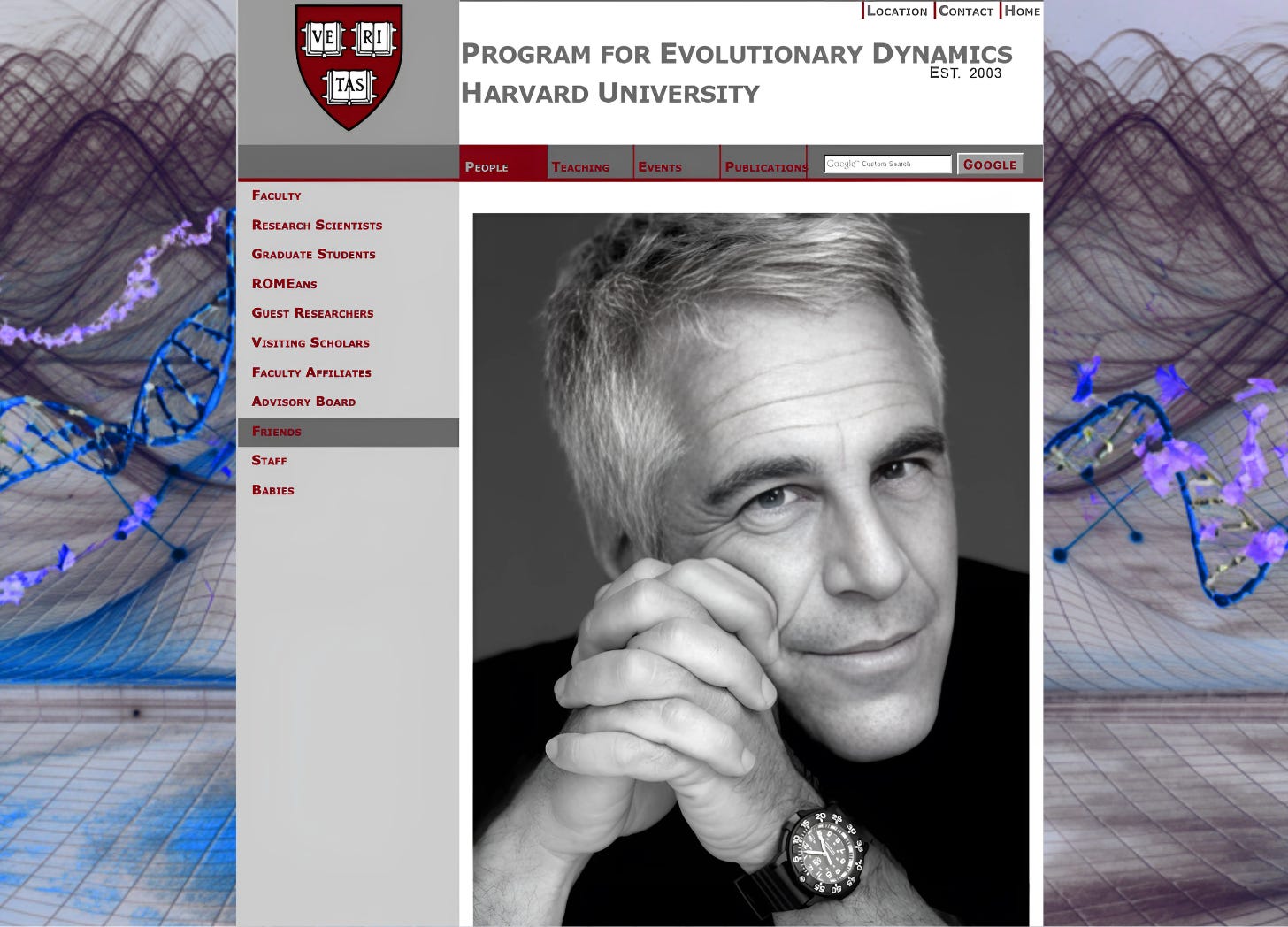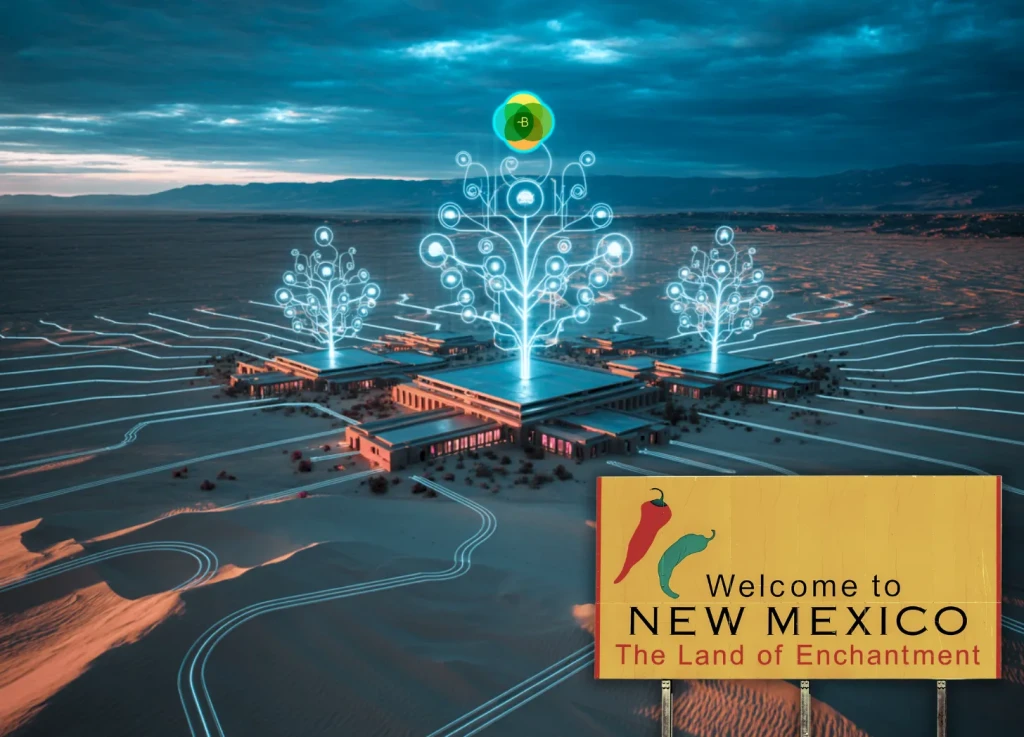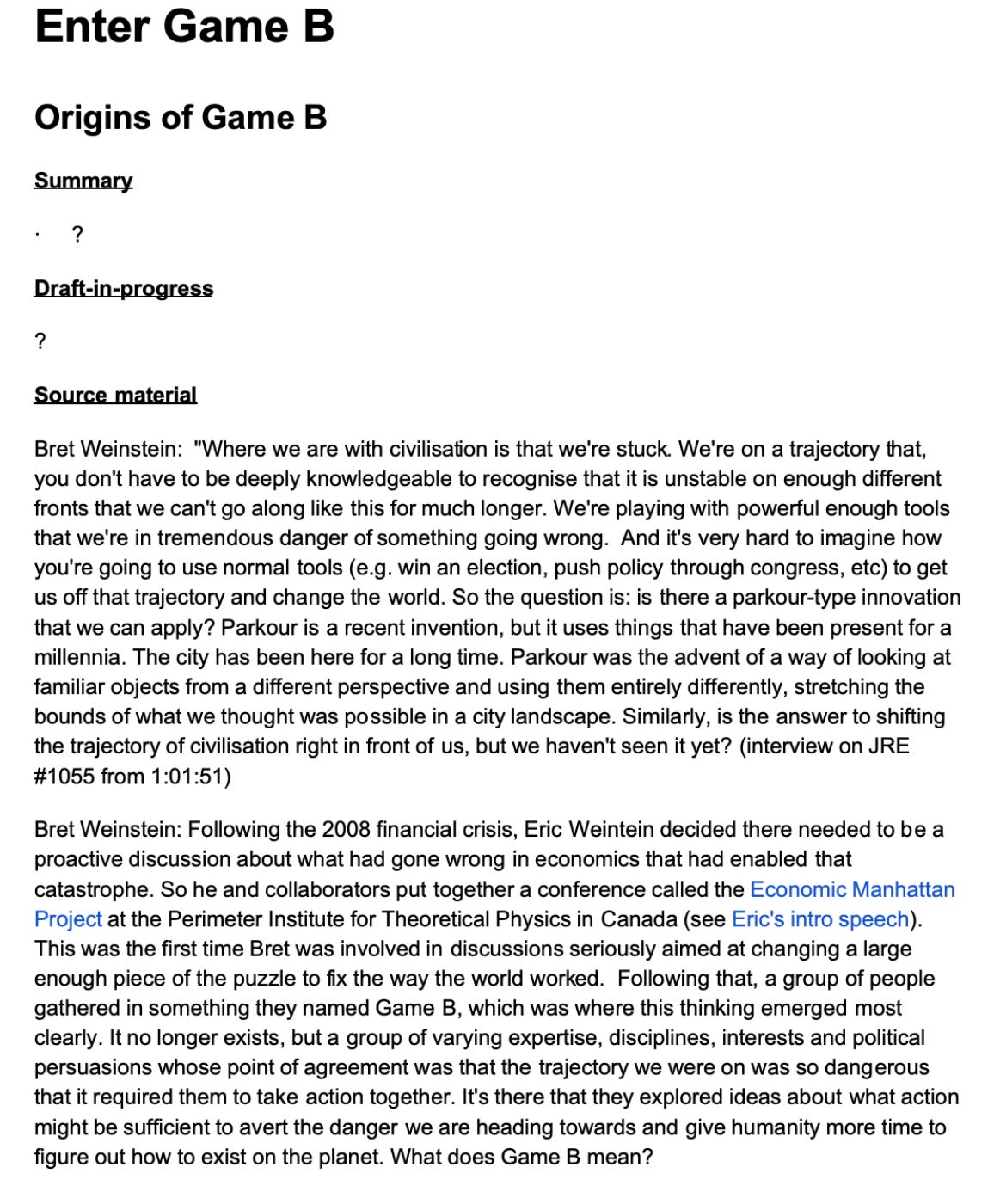Exposing the Shadowy Elite Network of DNA Seeding, Spiritual Culling, and Noospheric Control – From Epstein’s Island to AI Godhood
Imagine unlocking the secrets of human “source code” to rewrite our destiny—transcending scarcity, competition, and even death itself. Sounds like a sci-fi utopia, right? But what if this vision is a Trojan horse for elite control, funded by Jeffrey Epstein and amplified by Silicon Valley titans? Dive into the shadowy origins of Game-B, a movement promising collective flourishing but potentially delivering a dystopian nightmare of genetic engineering, AI overlords, and spiritual eugenics. If you’ve ever wondered how the Intellectual Dark Web, Santa Fe Institute, and Epstein’s billions connect to a plan for “conscious evolution,” keep reading—this exposé will blow your mind.
Table of Contents:
Introduction: The Last Questions and the Hidden Game
Section 1: The Game-B Origin Story: From Santa Fe Think Tanks to Civilizational Redesign
Section 2: The Epstein Nexus: Funding the Future of Human Enhancement
Section 3: Ideological Roots and Dangers
Section 4: The Intellectual Dark Web as Influence Operation?
Section 5: Benevolent Intentions, Unintended Consequences: The Philosophical Roots Leading to Transhumanism and Technocracy
Conclusion: Game~B as a Technocratic and Transhumanist Trojan Horse?
Bibliography: Source list and links
Short Breakdown of Each Section
- Introduction: The Last Questions and the Hidden Game
Sets the stage with the Edge Foundation’s 2018 “last questions” series, highlighting the Weinsteins’ contributions and introducing Game-B as a response to Game-A’s flaws. Teases the movement’s seductive promise of conscious evolution while revealing its dark ties to Epstein, SFI, Thiel, and technocratic risks, including Pierce and Bannon connections. - Section 1: The Game-B Origin Story: From Santa Fe Think Tanks to Civilizational Redesign
Traces Game-B’s roots at SFI (with Epstein funding), the 2009 Economic Manhattan Project, and 2013 gatherings. Details key figures (Rutt, Hall, Weinsteins, Schmachtenberger, Landry), internal conflicts, evolution into a memetic tag, and a timeline from 2002 to 2025, questioning if it’s a paradigm shift or technocratic rebrand. - Section 2: The Epstein Nexus: Funding the Future of Human Enhancement
Examines Epstein’s foundational role in funding institutions like Edge, Harvard, MIT, SFI, and transhumanist groups (e.g., Humanity Plus). Highlights ties to figures like Church and Goertzel’s AI for Good/UN links, Epstein’s eugenic ambitions, and amplifiers like Thiel’s ventures and Brock Pierce’s crypto overlaps, with a timeline of donations. - Section 3: Ideological Roots and Dangers
Explores conscious evolution’s roots in Teilhard de Chardin’s noosphere and Hubbard’s spiritual eugenics, linking to genetic eugenics and Darwinism. Critiques risks of surveillance and elite control, drawing parallels to historical technocracies like Technocracy Inc. and Wells’ World Brain, warning of hubris in AI-driven systems. - Section 4: The Intellectual Dark Web as Influence Operation?
Analyzes the IDW (coined by Eric Weinstein) as an incubator for Game-B ideas, evolving into the IDWeb. Discusses overlaps with Game-B language, figures like Schmachtenberger and Hall, podcasts, and speculations on intelligence ties, critiquing it as manufacturing consent through complexity. - Section 5: Benevolent Intentions, Unintended Consequences: The Philosophical Roots Leading to Transhumanism and Technocracy
Acknowledges proponents’ good intentions but critiques Game-B’s roots (ontological, teleological, metaphysical, epistemological) for leading to transhumanism/technocracy. Details defenses (e.g., Schmachtenberger on anti-rivalrous tech), critiques decentralization illusions, and ties to ventures like Qualia Life and CosmoErotic Humanism. - Conclusion: Game-B as a Technocratic & Transhumanist Trojan Horse
Summarizes Game-B’s origins, roots in eugenics/technocracy, Epstein/Thiel ties, and IDW influence. Warns of risks in conscious evolution becoming control, urging resistance through education, local action, and rejecting enhancements to preserve human agency. - Bibliography
Lists sources cited throughout the essay, including books, articles, podcasts, and websites.
Introduction: The Last Questions and the Hidden Game

In the summer of 2018, as global anxieties simmered over climate collapse narratives, technological disruption, and geopolitical instability, the Edge Foundation—an elite intellectual salon founded by literary agent John Brockman—hosted its annual series where it posed what it billed as humanity’s ultimate challenge: “What is the last question?” This wasn’t just another thought experiment; it was framed as the final inquiry that could define our species’ trajectory, a call to arms for the world’s brightest minds to confront existential perils. Among the over 150 contributors, including psychologists, physicists, and philosophers, two brothers stood out with queries that cut to the core of human evolution and self-mastery.
Bret Weinstein, an evolutionary biologist and podcaster known for his contrarian takes on culture and science, submitted: “Can humans set a non-evolutionary course that is game-theoretically stable?” His brother, Eric Weinstein, a mathematician and former managing director at Thiel Capital, offered: “Does something unprecedented happen when we finally learn our own source code?” These weren’t idle speculations. They echoed through salons attended by Nobel laureates and Silicon Valley titans, questions that implied humanity stood at a precipice: decode our biological and social programming, or succumb to the chaotic forces of natural selection run amok.
On the surface, the Weinsteins’ provocations captured a seductive promise—a vision of “conscious evolution,” where humanity transcends its primal instincts for competition and scarcity, engineering instead a cooperative, resilient future. This idea crystallized in Game~B, a movement the brothers founded and helped popularize alongside thinkers like Jordan Hall, Jim Rutt, and Daniel Schmachtenberger, Forest Landry. Game-B positions itself as the antidote to “Game-A,” our current zero-sum societal operating system: the cutthroat capitalism, environmental exploitation, and power asymmetries driving us toward collapse. Instead, Game-B envisions “omni-win” dynamics—scalable, anti-fragile systems built on collective intelligence, advanced technologies like AI and blockchain, and psychotechnologies for enhanced sense-making.
Imagine a world where decentralized autonomous organizations (DAOs) replace corrupt governments, where algorithms curate “optimal” decisions from vast citizen inputs, and where evolutionary traps like arms races are preempted by game-theoretically stable incentives. It’s a protopian dream—not utopia, but a steady upgrade toward sustainability and flourishing. As Schmachtenberger often puts it, “If technology gives us something like the power of gods, we have to have something like the love and wisdom of gods to be able to rightly wield it.” Hall, in a nod to ancient myths, calls for “Promethean” innovation, stealing fire from the gods of old paradigms to forge new ones. Rutt, drawing from his Santa Fe Institute roots, sees social media evolving into “premier sense-making platforms” for the human race.
Currently Game-B remains more conceptual than concrete, a “loose network of individuals and groups” per the P2P Foundation Wiki, inspiring experiments in “Proto-B” communities, drawing comparisons to Jacque Fresco’s Venus Project—a resource-based economy vision. Online forums buzz with discussions of transitioning away from the “metacrisis state,” while the @GameBMovement X account promotes collaboration and sustainability. A planned video series on Game-B projects hints at growing momentum, yet the movement’s allure lies in its ambiguity: It’s not a rigid ideology but a “memetic tag” aggregating visions for a non-rivalrous civilization.
Peel back the layers, to examine the ramifications of the connections, intellectual and spiritual foundations and a darker underbelly emerges. The Edge Foundation, where these “last questions” were aired, wasn’t a neutral agora. From 2001 to 2015, it received at least $638,000 from Jeffrey Epstein, the convicted sex offender and financier whose web of influence snared scientists, billionaires, and politicians. Epstein wasn’t just a donor; he was often the sole benefactor, attending exclusive “Billionaires’ Dinners” to cultivate ties with the likes of Stephen Hawking, Marvin Minsky, and George Church—pioneers in AI, genetics, and transhumanism. His funding extended to Harvard’s Program for Evolutionary Dynamics ($6.5 million), MIT’s Media Lab ($525,000 post-conviction), and transhumanist outfits like Humanity Plus ($100k + $20k + $100k), all while he harbored eugenic fantasies of “seeding” humanity with his DNA via a New Mexico “baby ranch.”

Epstein’s empire intersected Game-B’s origins at the Santa Fe Institute (SFI), where he donated $275,000, and where Rutt chaired the board (2009-2012) while Hall served as a trustee (2007-2011). SFI’s complexity science—modeling emergent systems and evolutionary dynamics—forms Game-B’s intellectual spine. More provocatively, Epstein invested $40 million in Valar Ventures, a firm co-founded by Peter Thiel, the PayPal billionaire and transhumanist patron who funds longevity research and “liberal eugenics” via embryo-selection startups like Orchid. As of June 2025, that stake has ballooned to $170 million, the largest asset in Epstein’s estate—profits that, per reports, victims may never see. Peter Thiel’s orbit serves as a powerful amplifier for these technocratic visions, channeling Epstein’s investments into transhumanist frontiers like anti-aging research (via SENS), AI development (through the Singularity Institute), and cryonics (Alcor). Thiel’s recent backing of the Enhanced Games, a “doping Olympics” for superhuman performance, further echoes the movement’s pursuit of transcending human limits, potentially entrenching elite control under the guise of innovation. Eric Weinstein, during his tenure at Thiel Capital (2013-2022), worked under the umbrella that housed Valar, raising questions about indirect ties—though Weinstein has publicly called Epstein a “constructor,” likely an intelligence asset steering science.
Brock Pierce, a cryptocurrency pioneer and co-founder of Tether and Block.one, intersects with Jeffrey Epstein’s network through his attendance at Epstein’s 2011 “Mindshift” conference on Little St. James island, where he spoke on blockchain technology alongside scientists and Nobel laureates, despite Epstein’s recent conviction for soliciting prostitution from a minor. Pierce has also been reported to have counseled Epstein on cryptocurrency investments, overlapping in the emerging crypto economy that Epstein funded through ventures like his DNA data-mining firm Southern Trust. Pierce later expressed regret over the association, claiming ignorance of Epstein’s full role as sponsor and stating he would not have participated knowing Epstein’s history. This Epstein tie extends to Pierce’s collaborations with Steve Bannon, whom Pierce employed at his company Internet Gaming Entertainment in the mid-2000s (focused on virtual gold farming in World of Warcraft), with Bannon eventually replacing him as CEO; Bannon later assisted Pierce’s 2022 independent U.S. Senate bid and has been involved in crypto projects alongside him. Pierce’s independent political ambitions, including his 2020 presidential run, align with broader movements like United Independents—emphasizing decentralized governance and systemic reform—which share ideological overlaps with Game-B’s anti-rivalrous visions through figures like Christopher Life, though Pierce’s direct involvement centers on crypto-driven civic activism.
Recent discussions amplify suspicions: podcasts, articles and posts on social media link Epstein to Mossad honey-traps, CIA replicas, and elite blackmail networks, with vague nods to “game designers” on flight logs. While direct Game-B-Epstein smoking guns are elusive, the overlaps suggest a technocratic agenda: Using evolutionary rhetoric to justify elite oversight, where “decoding source code” enables god-like reprogramming of society and biology.
We will explore how Game-B, echoes historical technocracies—from 1937’s Technocracy Inc., which advocated “social engineering” sans politicians, to Pierre Teilhard de Chardin’s “noosphere,” a planetary mind merging humans into a tech-mediated superintelligence. It draws on Barbara Marx Hubbard’s “spiritual eugenics,” where “unevolved” elements are culled for planetary progress, and H.G. Wells’ “World Brain” of expert-curated knowledge. In 2025, amid AI booms and trust deficits, Game-B’s promise risks entrenching power in code-masters—designers of algorithms that process us as data, not sovereign agents.
What if “conscious evolution” isn’t liberation, but a blueprint for control? By teasing these threads—Epstein’s funding as incubator, SFI as birthplace, Thiel’s orbit as amplifier—we reveal Game-B not as escape from Game-A, but its sophisticated evolution: A potential technocratic, transhumanist takeover disguised as salvation.
Section 1: The Game-B Origin Story: From Santa Fe Think Tanks to Civilizational Redesign

The seeds of Game-B weren’t sown in a revolutionary uprising or a viral social media campaign, but in the rarified air of elite think tanks and private gatherings among systems theorists, tech entrepreneurs, and evolutionary biologists. At its core, Game-B emerged as a response to what its proponents saw as the fatal flaws of “Game-A”—the dominant societal paradigm characterized by competition, short-termism, and destructive externalities like ecological collapse and social inequality. Instead, Game-B promised a “new operating system” for civilization: one rooted in cooperation, long-term stewardship, and technologically enhanced collective intelligence. To understand its trajectory, we must trace its origins back to the Santa Fe Institute (SFI), a New Mexico-based research center renowned for complexity science, where key figures first crossed paths, as well as earlier post-2008 initiatives led by Eric Weinstein that laid conceptual groundwork.
Founded in 1984, SFI has long been a nexus for interdisciplinary exploration of emergent systems—how simple rules give rise to complex behaviors in everything from ant colonies to financial markets. It’s here that Jim Rutt and Jordan Hall (formerly Robert Jordan Greenhall) forged connections that would birth Game-B. Rutt, a former tech executive who built his fortune in network services and venture capital, joined SFI as a Researcher in Residence from 2002 to 2004, focusing on applying complexity principles to financial markets, social organizations, and evolutionary artificial intelligence. He later ascended to Chairman of the Board from 2009 to 2012, and remains a Distinguished Fellow and Trustee Emeritus as of 2025. Hall, a tech innovator with roots in digital media and AI, served on SFI’s Board of Trustees from approximately 2007 to 2011. His interests aligned closely with the institute’s: the co-evolution of technology and human civilization, including complex adaptive systems and networked governance.
Their shared SFI tenure overlapped during a period when the institute received $275,000 from Jeffrey Epstein, including a $25,000 donation in 2010, as reported by AP News, KRQE, and the Virgin Islands Daily News. Epstein’s involvement at SFI stemmed from his friendship with physicist Murray Gell-Mann, a co-founder and science board co-chair, who acknowledged Epstein’s support in his 1994 book The Quark and the Jaguar. This funding context underscores how Game-B’s intellectual foundations were nurtured in environments buoyed by controversial patrons, blending cutting-edge science with elite networking.
The intellectual precursors to Game-B can be traced even earlier, to the aftermath of the 2008 financial crisis, when mathematician and economist Eric Weinstein organized the “Economic Manhattan Project” conference at the Perimeter Institute in 2009. This initiative aimed to assemble scientists and thinkers to rethink economic theory as a science, addressing systemic failures through an interdisciplinary “Manhattan Project”-style effort to develop new models for stability and growth. Eric Weinstein, often referred to in Game-B circles as the “rabbi” of the movement for his guiding philosophical influence, framed these discussions around evolving human systems and game-theoretic principles. His brother Bret Weinstein, an evolutionary biologist, was involved in these early talks, contributing insights on how systems evolve unpredictably and emphasizing the need for designs that account for emergent behaviors to avoid unintended consequences. These post-2008 explorations, documented in introductory overviews like the “On Game B” text, served as a historical bridge to later Game-B formations, evolving ideas from economic redesign into broader civilizational alternatives.

The formal genesis of Game-B traces to 2013, when Rutt, motivated by societal challenges like economic inequality and environmental degradation, assembled a diverse group of thinkers. As Rutt recounted in a 2020 YouTube interview, “In 2013, Jim Rutt brought together a group of thinkers from different fields to address major societal challenges, leading to the origins of ‘Game B’.” Initial discussions aimed at launching a political party dubbed the “Emancipation Party,” but evolved into a broader conceptual framework for a sustainable social operating system. A pivotal in-person meeting in Staunton, Virginia, that year included Hall, who presented ideas for a non-hierarchical, network-centric social movement with a gradual “on-ramp” for participants—ideas that became the mental model for Game-B. Thor Müller, author of Get Lucky: How to Put Planned Serendipity to Work for You and Your Business, reportedly suggested they keep the name “Game B” during these talks for branding purposes.
Bret Weinstein was recruited for his expertise in evolutionary biology. As Bret explained in a 2020 video, “I was brought in because it was seen as evolutionary… we have a tendency to solve problems… the problem is that when we build these things… we’re not aware we’re building an entity that will evolve… we’ve done this time and again… set a system then it evolves to something we weren’t planning for.” His brother Eric, with his background in mathematics and economics, added a layer of game-theoretic rigor, with his Edge question alluding to framing human systems as programmable “source code.” Daniel Schmachtenberger, a systems thinker focused on existential risks, joined as a key voice, emphasizing “advancing collective intelligence and capacity” in the face of globalization and exponential technology. Forrest Landry, a philosopher, master woodworker, and systems architect with expertise in large-scale software design, emerged as a metaphysical guide for the movement. Drawing from his work on “Immanent Metaphysics”—a framework emphasizing effective choice-making, relational integrity, and the interdependence of being—he contributed tools for navigating complexity in small groups, influencing Proto-B experiments and the philosophical underpinnings of anti-fragile, scalable communities. (There’s many more names in the Game~B ecosystem but for the purposes of this article we won’t list them all. I cover most of them in depth in my presentation on Game~B.)
The group’s online discussions exploded, generating around 100,000 posts on Basecamp, but the in-person initiative disbanded after about a year due to internal conflicts. Jim Rutt explained that there was a more spiritual faction, “woo-woo” vs a more scientifically oriented group. The Manifest Nirvana Whitepaper explains, “In 2014 the Stanton group split into two camps: those who were convinced that real change has to start with institutional reform, versus those who believed that personal and spiritual transformation are a prerequisite for social change – and thus the primary foundations upon which a genuinely new Game B needs to be built. Some of the essential future aspirations for humanity of the latter group sound close to the original vision of collective evolutionary emergence we hold at Manifest Nirvana as well, and are well worth exploring further. Especially those expressed by inspirational thinkers like Jamie Wheal, one of the world’s leading experts on peak performance and leadership; Jordan Hall, techno-wizard turned philosopher; and Daniel Schmachtenberger, social philosopher and futurist.”
Dialogues likely continued among key players (e.g., Rutt, Hall, the Weinsteins, and Daniel Schmachtenberger), given their overlapping networks in complexity science and tech, but these weren’t publicized or framed as Game-B activities at the time. In 2017, Bret Weinstein discussed Game-B on the Joe Rogan Experience podcast in December 2017, marking the concept’s first notable public exposure since 2013. This was a solo effort to revive interest, drawing on evolutionary biology angles from the original talks. In 2018, Daniel Schmachtenberger launched The Emergence Project (a think tank focused on design criteria for omni-considerate systems, inspired by integral theory which later morphed into the Consilience Project, where Jordan Hall serves the role of “Strategic Intelligence”). This was a direct extension of Game-B thinking, involving ongoing discussions among a small circle, but it operated as an independent initiative. Game-B persisted informally, gaining traction around 2019 with the #GameB hashtag on social media. By then, it had coalesced into what the Game-B Wiki describes as “a memetic tag that aggregates a myriad of visions, projects and experiments that model potential future civilisational forms. The flag on the hill for Game B is an anti-fragile, scalable, increasingly omni-win-win civilisation.” The wiki, last significantly updated in March 2024, positions Game-B as distinct from “rivalrous Game A,” drawing on evolutionary game theory, complexity science, and systems thinking.
Proponents like Schmachtenberger describe it as a shift from “adversarial, finite games” to “infinite games” where the goal is perpetual play through mutual benefit. Hall, in early formulations, warned that “Game B is notoriously difficult to think and talk about for the very good reason that if you were using the conceptual structures that came out of Game A to do so, you may very well be poisoning the well.” Other voices, such as Zak Stein, Tyson Yunkaporta, and Nora Bateson, enriched the discourse with ideas from education, indigenous knowledge, and ecology.
By 2020, podcasts and videos amplified the message. In a Future Thinkers episode, Rutt discussed “Proto-B” communities—experimental groups applying Game-B principles in practice—and steps to adopt a Game-B mindset. A 2022 talk at Singularity University explored Rutt’s views on engineering a better society via Game-B, touching on online communities and social media.
While there’s much diversity of ideas in the the Game~B community, many of them are spiritual and philosophical disciples of Neoplatonism, Barbara Marx Hubbard, and Pierre Teilhard de Chardin. The movement’s evolution took a seemingly more traditionally religious turn in 2024 with Jordan Hall’s public conversion to Christianity, which he integrated into Game-B frameworks. In a February 2024 podcast with Jim Rutt (Episode 223), Hall discussed “cities, civiums, and becoming Christian,” exploring how hierarchies of values and cultural toolkits could align with Game-B’s anti-fragile aspirations. In a March 2024 “Trans-Paradigmatic Christianity” video, he offered Christianity as a worldview bridging innovation and tradition. This pivot continued into 2025, with an April video titled “Jordan Hall | Game B Christianity,” where he joined hosts to discuss fusing Game-B concepts with Christian theology. In his presentation The Rise of Network States and Smart Cities | Jordan Hall | Startups Societies Conference at Vitalia he applies Christian concepts to building Network States. The fusion of Christian ideas with the core tenets and visions of Game~B might feel a bit forced, like squeezing a square peg into a round whole, to those versed in both.
Into 2025, Game-B shows signs of modest revival.
Timeline of Game-B Evolution:
- 2002-2004: Jim Rutt joins SFI as Researcher in Residence, focusing on complexity applications.
- 2007-2011: Jordan Hall serves on SFI Board; overlaps with Rutt’s chairmanship (2009-2012).
- 2009: Eric Weinstein in conjunction with the Edge foundation, organizes the Economic Manhattan Project conference at Perimeter Institute, involving Bret Weinstein, introducing Jordan Hall and laying early groundwork for rethinking systemic failures that influenced Game-B.
- 2013: Rutt convenes group; Staunton, VA meeting; Hall presents core ideas; Bret Weinstein joins for evolutionary lens. Initial aim: Emancipation Party. ~100,000 Basecamp posts; project disbands after ~1 year.
- 2019: #GameB hashtag gains traction on social media; Game-B Wiki launches, defining it as “memetic tag” for omni-win civilization.
- 2020: Podcasts/videos proliferate; Rutt on Future Thinkers discusses Proto-B communities.
- 2024: Jordan Hall converts to Christianity; integrates with Game-B in podcasts (e.g., EP 223 with Rutt on “civiums”); “Trans-Paradigmatic Christianity” video.
- 2025: January Facebook post announces new video series; @GameBMovement X active in March
This timeline reveals Game-B’s shift from ambitious political origins to a more philosophical, spiritually infused network. Yet, its SFI roots and elite composition raise questions: Is this a genuine paradigm shift, or a technocratic rebrand? As we explore further, these ties to Epstein-funded ecosystems and transhumanist ideologies suggest possibly the latter.
Section 2: The Epstein Nexus: Funding the Future of Human Enhancement

Jeffrey Epstein’s role in the ecosystem surrounding Game-B wasn’t that of a peripheral donor or casual enthusiast; it was foundational, and deeply intertwined with the movement’s intellectual and financial roots. As a convicted sex offender who positioned himself as a “science philanthropist,” Epstein funneled millions into institutions and individuals advancing transhumanism—the philosophical and technological pursuit of transcending human biological limits through genetic engineering, AI, longevity research, and collective intelligence systems. Additionally, his involvement in cryptocurrencies both in regard to personal investments as well and technological research and innovation raises inquiries regarding technocratic visions. According to the Jeffrey Epstein VI Foundation’s own description, established in 2000, Epstein aimed “to fund and support cutting edge science around the world.” He portrayed himself as “one of the largest supporters of individual scientists, including theoretical physicist Stephen Hawking, Marvin Minsky, Seth Lloyd and Nobel Laureates Gerard ‘t Hooft, David Gross and Frank Wilczek.” More recently, his foundation backed advances in artificial intelligence, such as the OpenCog Foundation in Hong Kong and Joscha Bach’s Micropsi work in Berlin, which focused on building virtual cognitive models of the human mind. Epstein was also actively involved in the Program for Evolutionary Dynamics, the Santa Fe Institute, the Theoretical Biology Initiative at the Institute for Advanced Study, the Quantum Gravity Program at the University of Pennsylvania, and Harvard’s Mind, Brain and Behavior Committee. He was a former member of the Trilateral Commission, the Council on Foreign Relations, the New York Academy of Science, and a Rockefeller University Board Member.
This funding web didn’t just support abstract ideas; it created networks that amplified ideologies central to Game-B, such as decoding humanity’s “source code” (Eric Weinstein’s Edge question), the related theme of Jordan Hall’s blog Deep Code, and engineering “non-evolutionary” social structures (Bret’s query). By examining Epstein’s contributions—millions to scientific causes, per known records—we uncover how his influence helped incubate a technocratic vision where elites, armed with advanced tools, could steer human evolution.

At the heart of this nexus was the Edge Foundation, which served as Epstein’s primary gateway to the intellectual elite. Founded in 1988 by John Brockman, Edge.org functioned as a highbrow salon, hosting annual questions, conferences, and exclusive events like the “Billionaires’ Dinner.” These gatherings connected scientists, philosophers, and entrepreneurs, fostering discussions on “the third culture“—where systems thinkers and technologists supplanted traditional humanities as cultural authorities. From 2001 to 2015, Epstein’s foundations donated at least $638,000 to Edge, often as its sole or largest contributor, according to IRS filings and Brockman’s own admissions post-scandal. This wasn’t passive philanthropy; Epstein attended events, sponsored dinners, and used the platform to build relationships with luminaries like Stephen Hawking, Marvin Minsky (AI pioneer), and Murray Gell-Mann (SFI co-founder), whom he visited monthly in New Mexico to discuss particle physics.
Edge’s “last question” series in 2018, where the Weinsteins posed their queries, exemplifies how it incubated transhumanist ideas. Eric’s question about “source code” evoked decoding human cognition and biology as software, unlocking enhancements like longevity or post-biological existence. As Weinstein elaborated in discussion with Lex Fridman, “and another case we are the simulated and if you buy those and you put them together we are the AGI and whether or not we have simulators we may be trying to wake up by learning our own source code so this could be our Skynet moment…” This framing not only blends simulation theory with AGI self-awareness but also underscores the existential stakes—humanity potentially triggering its own obsolescence through self-decoding. Bret’s on a “game-theoretically stable” non-evolutionary path aligned with redesigning society beyond zero-sum Darwinian traps—core to Game-B’s diagnosis of Game-A failures. These themes weren’t new to Edge; annual questions often revolved around AI convergence, the “global brain,” and human upgrades, platforming figures like Ray Kurzweil (singularity advocate) and Nick Bostrom (existential risks philosopher). Epstein’s funding enabled this discourse, which echoed his own obsessions: He reportedly dreamed of “seeding” humanity with his DNA by impregnating women at his Zorro Ranch in New Mexico, inspired by eugenic sperm banks like the Repository for Germinal Choice.
Beyond Edge, Epstein’s largesse extended to major academic institutions, creating scandals that continue to reverberate in 2025. Harvard University received the lion’s share: at least $8.9 million between 1998 and 2007, per a 2019 internal review reaffirmed in a July 2025 Crimson article on lingering Epstein ties. The centerpiece was a $6.5 million gift in 2003 to establish the Program for Evolutionary Dynamics (PED) under Martin Nowak, focusing on mathematical models of evolution—directly relevant to Game-B’s evolutionary critiques. Even after Epstein’s 2008 conviction for soliciting prostitution from a minor, he visited PED offices over 40 times between 2010 and 2018, including as late as October 2018. Harvard’s psychology department appointed him a visiting fellow post-conviction, despite his lack of credentials, following a $200,000 donation.
In July 2025, amid renewed White House scrutiny over Epstein-linked scandals, Harvard affiliates were revealed to have sent birthday letters to Epstein as recently as 2018, per declassified documents cited in a Crimson report. This ties into broader political fallout, with President Trump defending Attorney General Pam Bondi’s handling of Epstein files in a July 15, 2025, NBC interview. The university’s reluctance to fully sever ties highlights how financial incentives (or perhaps other motives) overrode ethical concerns, allowing Epstein to shape research priorities in evolutionary biology and genetics—fields echoing Game-B’s “conscious design” ethos.
MIT’s involvement was equally fraught, leading to one of academia’s biggest post-Epstein reckonings. Between 2002 and 2017, Epstein donated $850,000—$750,000 after his conviction—with $525,000 going to the Media Lab under director Joi Ito. Internal emails, exposed in a 2019 New Yorker investigation and referenced in 2025 updates on anonymous donations, showed lab officials marking Epstein’s gifts as anonymous despite knowing his identity and criminal history. Epstein also acted as an intermediary, facilitating millions from donors like Bill Gates and Leon Black, though Gates’ representatives dispute direct involvement. Professor Seth Lloyd, a quantum computing expert, received $225,000, including a $60,000 personal gift, and concealed Epstein’s role in 2012 and 2017 donations, violating MIT policies. Lloyd’s work on information as the universe’s substrate aligned with transhumanist goals of merging mind and machine.
A January 2020 MIT fact-finding report confirmed these engagements, leading to Ito’s resignation and policy reforms on donations. Brown University reportedly suspended an official amid Epstein gift probes.
Epstein’s transhumanist connections ran deepest through individuals like George Church and Ben Goertzel. Church, a Harvard geneticist pioneering CRISPR and synthetic biology, received funding from Epstein between 2005-2007 for “cutting-edge science and education.” His research—making humans virus-immune, eliminating diseases, reversing aging—mirrored Epstein’s eugenic visions. Church met Epstein “several times” annually post-conviction, including a 2014 dinner with Ito and Reid Hoffman, later apologizing in 2019 for “nerd tunnel vision.” No major 2025 updates on Church-Epstein ties emerged, but his genetic dating app (to screen for diseases) continues to draw eugenics comparisons, claiming that the app could help “eradicate all genetic diseases” if all people planned their breeding based on genetic sequencing, aligned with Epstein’s interests in using technology to control human reproduction.
Goertzel, vice chairman of Humanity Plus (formerly World Transhumanist Association), received his salary funded by Epstein’s $100,000 donation in 2011, plus another $100,000 to the organization in 2018 via Gratitude America Ltd. Goertzel, AGI researcher and OpenCog founder, denied direct funding for projects like Sophia the robot, but a July 2025 Grok tweet highlighted the connection, noting Epstein’s transhumanist advocacy. Humanity Plus received $220,000+ total, supporting visions of mind-machine merger. Goertzel’s work, however, extends beyond Epstein’s shadow, as he champions “AI for Good” through SingularityNET, a decentralized AI platform fostering projects like DigiTruck, a solar-powered classroom for rural Ethiopia, and Rejuve Biotech for longevity research. In a 2020 Forbes interview, he stated, “Any other problem humanity faces—including extremely hard ones like curing death or mental illness, creating nanotechnology or femtotechnology assemblers, saving the Earth’s environment or traveling to the stars—can be solved effectively via first creating a benevolent AGI and then asking the AGI to solve that problem.” His leadership in OpenCog and the AGI Society and ties to the UN and WEF, emphasizes “ethical” AGI to address global challenges like climate change, though his Epstein ties raise questions about the motives behind such visions. Goertzel contributed to the UN’s AI for Good Global Summit, where he discussed decentralized AGI (artificial general intelligence) and its potential societal benefits. In 2017, Sophia became the first robot to receive a UN title, appointed as the United Nations Development Programme (UNDP) Innovation Champion for Asia and the Pacific, promoting sustainable development goals (SDGs). In July 2023, Goertzel appeared alongside Sophia and other AI-enabled robots at a UN press conference in Geneva, where they addressed AI governance and the potential for robots to run the world more effectively than humans, organized by the ITU. Epstein’s own ventures amplified these aims: Southern Trust, his 2012 DNA data-mining firm, generated $200M+ by 2017, organizing algorithms for genetic predispositions. His $40M investment in Thiel’s Valar Ventures, revealed in June 2025 to be worth $170M (per NYT and Economic Times reports), links him to Thiel’s transhumanist empire—funding SENS (anti-aging), Singularity Institute (AGI), and Alcor (cryonics). This $170M stake, the estate’s largest asset, may evade victims’ claims.
Timeline of Jeffrey Epstein’s Funding and Involvement in Scientific Ventures
This timeline compiles key events, donations, and relationships related to Jeffrey Epstein’s support for scientific, transhumanist, and technocratic initiatives from what was able to compile in my research.







